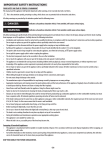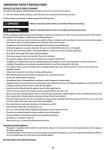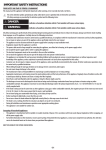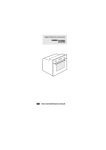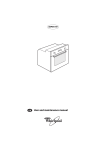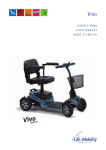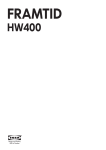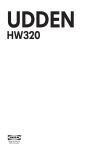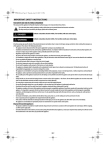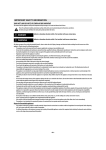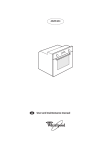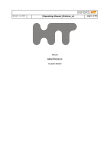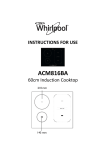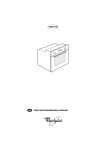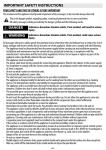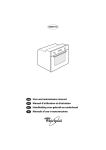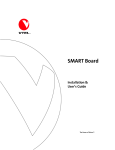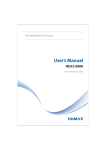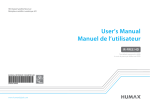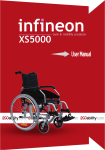Download HANDLEIDING USER MANUAL MODE D`EMPLOI
Transcript
Amara HANDLEIDING USER MANUAL MODE D’EMPLOI GEBRAUCHSANWEISUNG Contents Foreword4 Product description 5 Technical specifications 6 Safety instructions 7 Preparing the wheelchair for use 9 Settings and adjustments 10 Getting in and out of the chair yourself 13 Folding up the wheelchair 14 Transporting the wheelchair 16 Maintenance19 11-2010 Guarantee20 GB3 Product description Foreword Checking the wheelchair on delivery Before you start using your wheelchair, check that the wheelchair delivered matches the product description below. If you notice any damage caused during transit, please inform your dealer. We at Life & Mobility are sure that your Amara will meet your expectations and we wish you much success with it. As a wheelchair user, you naturally want to be seated comfortably. So the Amara can be individually adjusted to suit your own requirements. The armrests and the lower leg length of the legrests are height adjustable. The push handle is also adjustable, offering your accompanying person greater comfort. The swing away legrests and fold up footrests make it easier to get in and out of the chair. The sides, which are fitted with armrests, are also easy to remove. 1 2 The double crossframe makes the Amara extra stable, yet the wheelchair can be folded up in one single action. Because the frame is made of aluminium, the wheelchair is lightweight. As various parts can be removed, the chair is extremely compact when folded up. The Amara is therefore easy to transport in the car. 3 4 5 6 7 The Amara is water splash resistant and suitable for both indoor and outdoor use. 8 9 Maximum weight of user: 140 kg. This is indicated on the CE sticker. The Amara is in compliance with the relevant requirements of the European wheelchair standards EN 12182 and EN 12183, and therefore complies with the essential requirements of the Medical Devices Directive 93/42/EEC. Paragraphs in this document that are relevant to your safety are marked with the following safety symbol. GB4 Maximum user weight 140 kg Logistiekweg 7 7007 CJ DOETINCHEM T +31 (0)314 328000 E [email protected] * R 1 9 0 7 8 9 8 * Product description 1. Push handle 2. Backrest 3. Side fitted with armrest 4. Seat with removable cushion 5. Standard legrest 6. Standard brake 7. Frame 8. Wheel with handrim 9. Swivel castor Not illustrated: nn User manual nn Valve nipple nn Fixing pins for ankle angle (2x) Options and accessories The following options and accessories are available for the Amara: nn Drum brake control for the accompanying person nn Comfort legrest nn Extended tyre brakes nn Stick holder nn Anti-tipping support GB5 Safety instructions Technical specifications nn Seat width 37 / 42 / 47 / 52 cm* nn Seat depth 45 cm nn Seat height 50/52.5/55 cm (incl. seat cushion) nn Width (in combination with tyre brakes) = seat width + 22 cm nn Total weight = 16.3 kg nn Weight of heaviest component = 8.5 kg nn Maximum weight of user = 140 kg BR ZB Life & Mobility recommends using the Amara in an ambient temperature of between -5° and +40° Celsius. HD RH DL ZH AH ZD Cross-section through the middle of the chair. *D epending on the frame of your wheelchair. Assembly and adjustment nn Before you start using the wheelchair, check that the wheels, the sides with armrests and the legrests are properly fitted and securely fastened. nn Make sure that the push handles, the armrests and the lower leg length of the legrests are set to the right height. The legrests must be at least 5 cm off the floor. LR Use of the wheelchair nn NB: This wheelchair does not have anti tipping support. It may tip over if you lean back suddenly. nn NB: When using the chair on a slope, the centre of gravity will change and the wheelchair can tip over more easily. nn When propelling the chair manually, be careful of your hands if there is not much space to the left and right of the chair. nn Accompanying persons must never leave the wheelchair on a slope without engaging the brake. nn Never tackle obstacles higher than 10 cm on your own. Only experienced users with sufficient strength are generally capable of tackling obstacles up to 10 cm in height. nn Engage the brake on the wheelchair before getting out of the chair or transferring from it. nn Only use the brake to lock the stationary wheels. The brake is not suitable for slowing the wheelchair down. Transporting the wheelchair nn Make sure your fingers do not get caught when folding up the wheelchair. nn Never carry the wheelchair by the legrests or the armrests, but always by the frame. nn Make sure the wheelchair is completely unfolded before you use it again. The seat width cannot be adjusted. GB6 GB7 Safety instructions nn B efore you start using the wheelchair, check that the composition of the wheelchair, like the sides with armrests and the legrests are properly fitted and securely fastened. nn Make sure that the push handles, the armrests, the side cushions, the lower length of the legrests and possible the headrest are set to the right height. The legrests must be at least 5 cm off the floor. Slopes and other obstacles The wheelchair is more likely to tip over on a slope than on a level surface. nn Always go off a pavement or step backwards to prevent the wheelchair from leaning over forwards and the user from falling out of it. nn Never go down stairs in the wheelchair by yourself. nn Never ride the wheelchair up a slope with an incline of more than 5°. nn Ask somebody to help you if you are not sure whether you can reach the top of the slope by yourself. nn Lean or push your body in the direction of the top of the slope. This will shift the centre of gravity of the wheelchair to a better position and will reduce the risk of the chair tipping over. nn Do not turn the wheelchair round on a steep slope. If the wheelchair is facing across a steep slope, it can very easily tip over. nn Always keep your speed under control when going downhill. nn Only slow the wheelchair down with your hands on the handrims. Never use the brake, as this can cause you to lose control of the wheelchair. GB8 Preparing the wheelchair for use Unfolding the wheelchair Follow the instructions below before using the Amara for the first time. 1. Attach the legrests. 2. Fold back the footrests. 3. Lock the back GB9 Settings and adjustments Settings and adjustments For additional comfort, you can adjust the Amara to suit your own requirements. The settings given below are easy to implement. Your dealer can carry out the other settings and adjustments, such as adjusting the seat height, the ride characteristics and fixing the ankle angle, for you. A A A A Adjusting the push handle 1. Loosen the handle by one turn. 2. Adjust the handle to the required height. 3. Retighten the handle. The handles cannot be removed. Adjusting the ride characteristics The ride characteristics of the Amara are adjustable. nn Loosen the nut (A). nn Set the seat height as required. nn Retighten the socket screws. nn Move the wheel and axle plate forwards or backwards (the back axle hole gives you more stability and the front axle hole gives you a more comfortable ride; the ride characteristics change in relation to the seat depth). nn Retighten the nut. A Adjusting the armrests 1. Undo the socket screw (A). 2. Adjust the armrest to the required height. 3. Retighten the socket screw. Fixing the ankle hinge 1. Adjust the ankle angle to the required position. 2. Drill a hole in the hinge. 3. Fix the ankle hinge using the fixing pin provided. A Adjusting the legrest 1. Undo the socket screw (A) by one turn. 2. Set the legrest to the required lower leg length. Adjusting the seat height You can adjust the seat height to different heights. There are 4 axle holes available for adjusting the seat height. nn Loosen the socket screws (A). nn Set the seat height as required. nn Retighten the socket screws. nn If required, readjust the tyre brakes. A 1 NB: Make sure the legrest is at least 5 cm off the floor. ø 3 mm 3. Retighten the socket screw. 2 GB10 3 GB11 Settings and adjustments Getting in and out of the chair yourself Inflating the tyres This wheelchair comes with a valve nipple which you can connect to a bicycle pump to inflate the tyres. NB: Engage the brake on the wheelchair before getting in or out of the chair. NB: Check the tyre pressure. The correct tyre pressure is written on the tyre. To ensure a comfortable ride, it is important to make sure the tyres are at the correct pressure. The wheelchair will be more difficult to use if the tyre pressure is too low. Fold up the footrests or fold away the legrests (if applicable) by pressing the handle (A) down and tilting the legrest up slightly. NB: Never use the footrests as a step. A Take care when getting in and out of the chair. If transferring sideways, you can remove the sides and armrests. By turning this a quarter of a turn, you can remove the entire side. After replacing the side, retighten the securing pin by turning it back a quarter of a turn. GB12 GB13 Folding the wheelchair Folding the wheelchair Fold up the footrests. You can remove the sides and armrests. There is a securing pin at the front. By turning this a quarter of a turn, you can remove the entire side. After replacing the side, retighten the securing pin by turning it back a quarter of a turn. Remove the cushion. You can remove the wheels. Disengage the brake, press down on the axle and it will be released from the catch. Pull the catch on the back upwards. You can remove the legrests. Press the catch (A) in and lift out the legrest upwards. A Pull up the seat using the strap.The wheelchair will then fold up. GB14 GB15 Transporting the wheelchair Transporting the wheelchair Taxibus The Amara has been tested positively by the TNO as a ‘Crashtest safe wheelchair’ in compliance with ISO 7176-19. It can therefore be transported with the user in it in a taxibus (see also the sticker on the wheelchair). However, whether the wheelchair user can be safely transported depends on the state of his or her health; the user’s physician should be consulted. Life & Mobility recommends transferring the user from the Amara into a fixed seat if possible. figure 1 nn T he Amara has been dynamically tested in a forwards direction, with the test dummy (75 kg) secured with a lap belt and a shoulder belt. Its suitability in other collisions (e.g. lateral) has not been tested. nn The Amara must be fastened to the floor of the taxibus with a four-point securing system. figure 4 nn nn figure 5 nn 1 ˚55 NB: if there is no ex-factory Crashtest safe sticker on the wheelchair, it is not a wheelchair which can be transported safely. 2 nn nn T he positions of the four securing points on the Amara are shown with a hook symbol sticker (see figure 2). nn The Amara must be secured to the floor using an anchoring system that is suitable for use with the hook eyes (see figure 3). nn The user must wear a three-point safety belt in the taxibus. These safety belts must be attached to the taxibus. nn The lap belt must be positioned low across the user’s waist. The angle between the belt and the floor must be between 30° and 75° (a bigger angle is better). See figure 4. nn The lap belt must run over the front of the GB16 nn figure 2 figure 6 nn figure 3 body following the line where the hip and the pelvis meet. The belt must closely follow the body here. The top belt must fully support the user as illustrated in figure 5. nn The diagonal belt must be positioned across the user’s shoulder and chest as shown in figure 6. nn The belt must be sufficiently tight but not uncomfortable for the user. nn The belt must not be twisted. nn The belt must not come into contact with components of the wheelchair (such as armrests or wheels) in such a way that it does not fully support the user’s body (see figure 7). The Amara must be transported with the user facing forward. The wheelchair must be secured in accordance with the securing system manufacturer’s instructions. The three-point safety belt is intended to avoid injury to the head and chest. If a worktop is fitted, it must be removed in order to prevent injury to other passengers. The worktop should be safely stowed away elsewhere in the vehicle. If possible, any accessories must be secured or removed. Following an accident, a representative of the factory must inspect the wheelchair to determine whether it can still be used. The attachment points, structural components and frame components must not be modified or replaced without first consulting the manufacturer. figure 7 GB17 Transporting the wheelchair Car In addition to a taxibus, the Amara can also be transported folded in a car boot. See page 14 for instructions on folding up the wheelchair. The wheelchair can be lifted into the car by two adults. Maintenance Cleaning Clean your wheelchair with a damp cloth, water and an all purpose cleaner. NB: Never use aggressive cleaners or solvents (thinners, benzine or similar). Consult your dealer for information on disinfecting your wheelchair. Minor maintenance (every two weeks) Check the tyre pressure. Soft tyres reduce the effectiveness of the brake and make the wheelchair more difficult to use as they increase resistance. Check that all fastenings are secure. Tighten if necessary. NB: Overtightening the screws can damage the wheelchair. Check the hinged components on the folding frame. Lubricate sparingly with Teflon spray if necessary. Major maintenance (annual) Your dealer will be happy to carry out the major maintenance of your wheelchair free of charge. You can then be sure that you will be getting the best possible use out of your wheelchair. You should also consult your dealer if components need replacing. GB18 GB19 Guarantee Life & Mobility guarantees the Amara against faulty materials and manufacturing faults for a period of 1 year. Life & Mobility’s obligation arising from this guarantee is limited to the repair or replacement of components. The guarantee does not cover breakages caused by: failure to comply with instructions for use and maintenance instructions, abnormal use, wear and tear, negligence, overloading; accidents caused by third parties, use of non original components or breakages the cause of which is not related to the product. This guarantee supersedes any other guarantee laid down in law or verbally notified, with the exception of any written guarantee provided by Life & Mobility. Guarantees are only valid within the EU. GB20 Uw dealeradres: / Your dealer’s adress: / Adresse de votre revendeur: / Adresse Ihres Händlers: P.O. Box 304, NL - 7000 AH Doetinchem Logistiekweg 7, Doetinchem T +31 (0)314-328 000 F +31 (0)314-328 001 I www.life-mobility.com E [email protected]













